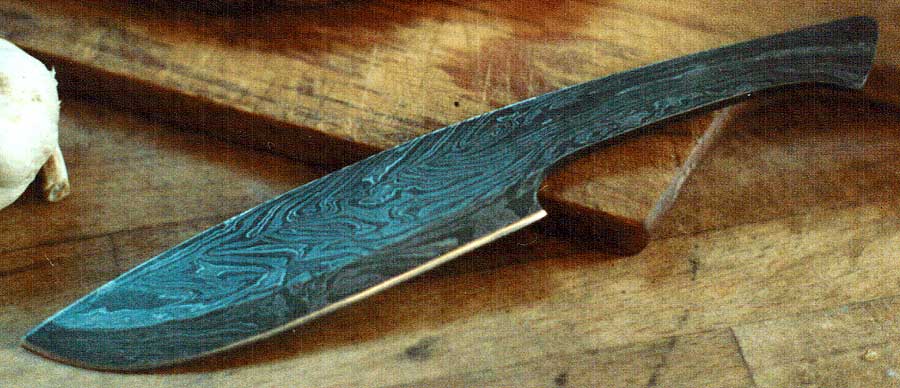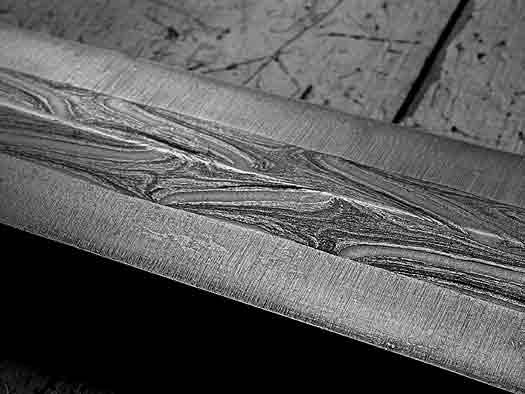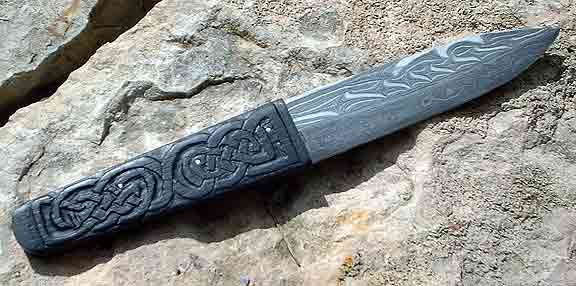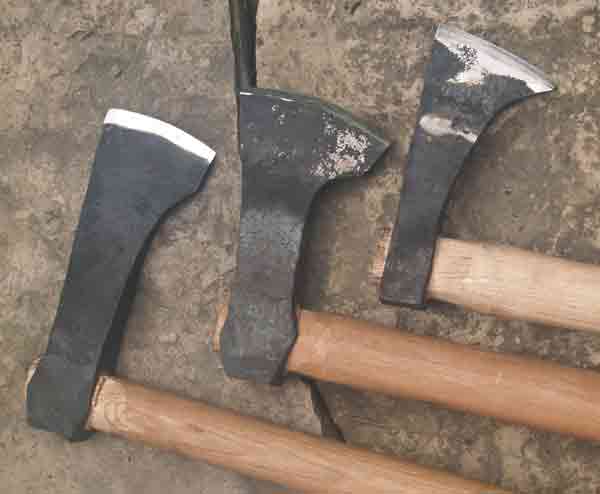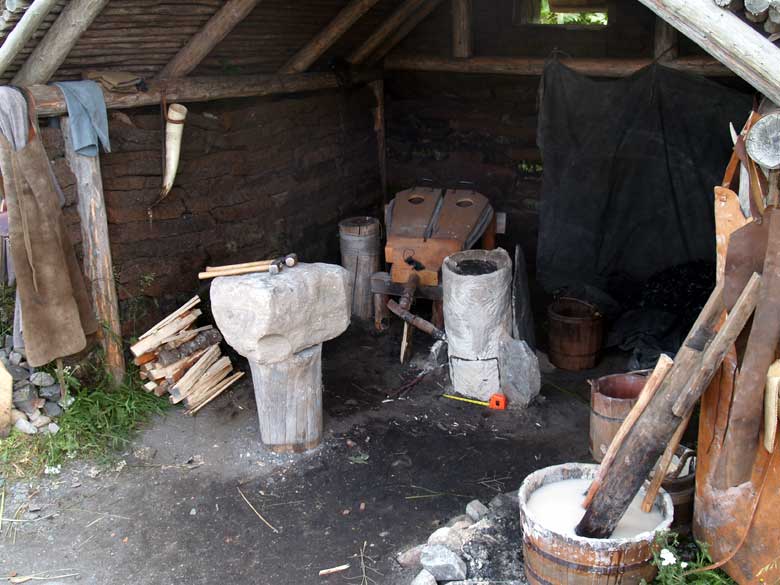I was a bit surprised that I have been asked to contribute to a very good series underway over on Don Fogg's Bladesmith Forum.
The series is entitled 'Knifemaker Interviews'. The idea was started by Christopher Price. Some of the best known and respected names have been included. The method is that Christopher asked a selected bladesmith (it was Allan Longmire) :
How this works: I will start by inviting a member here to an interview,
where we'll discuss their history, views of the craft, their relevant
background, and what makes them tick. They, then, will interview someone
else, and so on as long as we have people willing to pour out their
hearts and metalworking souls online for this community to share in.
Individuals have given intensely personal observations on their work and purposes, on the Arts and sometimes world view in general. This is inspiring stuff!
I was extremely flattered to be asked by Sheldon Browder (retired master smith from Colonial Williamsburg and fellow member of the Early Iron Group) to take part :
Quote
Darrell, i think that Some discussion of your connection with Viking
iron making a t L' Anse au Meadows might be a good place to start.
A
fast start : I am especially honoured (and humbled) to be included in
such august company. There are a great many names here from who's hands I
have always seen spectacular work. (An awful lot of 'I wish *I* could
have made that one'!) Some have come to be friends over the years, much
to my surprise and gratification. I hope it proves I can add something
to this quite wonderful (and informative) ongoing conversation.
At its best, this series reminds me a bit of an artist's round table at an extremely good conference...
To the Question:
You may personally find a curious circle here Sheldon.
(Cautionary note : This is how I remember this - maybe not the truth of what it really might have been!)
Second Cautionary note : I am not known for short answers!
I
was working as the blacksmith / historic interpreter at Black Creek
Pioneer Village (Toronto Ontario) in the mid to late 1980's. This is one
of those synthetic historic villages, composed of buildings moved from
their original locations and restored to the dates of construction. The
span there is roughly 1816 - 1865. The blacksmith's shop was intended to
be some vague 1850's time period. Individual interpreters came into the
Village mostly self taught, and mostly spent their days working alone.
(There was no internal training program such as exists at Colonial
Williamsburg in Virginia.)
I had started my journey into
living history through a deep interest in the Viking Age. I had
literally fallen over the then fledgling Society for Creative
Anachronism group at University of Toronto while a student at Ontario
College of Art. (As many are sure to know, this is a very loosely
Medieval themed organization.) As I was a young male, armoured combat
(as it was developing in the SCA in those days) was something I was
enthusiastically involved in. If you wanted armour back then (late
1970's) you pretty much had to build your own. A need for something at
least vaguely approaching historic objects for costumes lead me to my
first knives. (How I picked up a hammer for forging a longer tale!)
So that (roughly) sets the scene.
In
general research, likely via the ALHFAM journal, I had seen an article
describing a project undertaken by a team at Colonial Williamsburg. The
name I * remember * is 'David Harvey'. (Shel, you might remember this -
or have even been involved?) Anway, the project was an attempt to
convert a local iron ore into a metallic mass. As I remember it, this
was done using a deep built forge hearth, firing charcoal. The results
were marginal, with enough metal produced to make a small chisel. (In
retrospect, this all sounds like the variation on the Aristotle Furnace
Tim Young had suggested to the Early Iron Group at Smeltfest a couple of
years back, you certainly remember. Lee Sauder and Jesus Hernandez both
took the lead on those experiments.)
Back to the thread - I had
been 'offended' by the statement made in the published article : 'This
process replicates the First Iron Production in North America.' Like all
Canadians, this kind of thing gets the maple syrup in my veins just a
boilin'. * We * all knew the very first iron produced in North America
was at the hands of the Norse, at 'Leif's Houses' (northern
Newfoundland) in Vinland - some time about 1000 AD.
So in the back of my head, as early as about 1990, was the idea of demonstrating the Viking Age iron smelting process.
Through
a long chain of events (including a huge amount of mindless self
promotion). I would develop a working relationship with Parks Canada,
the L'Anse aux Meadows National Historic Site (LAM), and Dr Birgitta
Wallace. This all over the 1990's, with many trips out to the site from
my home base in central Ontario. (For those not familiar, that's a two
and half day drive, an eight hour ferry, then another full day's drive.)
In
2001, Parks Canada received a corporate grant to re-create the small
'Furnace Hut' at LAM. The original was a roughly 3 x 3 metre structure,
open on one side, dug into the bank of the Black Duck Brook. It appears
to have been purpose built to contain a small clay walled iron smelting
furnace. The furnace was either broken on bloom extraction (my best
guess), or purposefully converted into a deep forge for the required
compaction phase. The archaeology suggests only a single firing, a
smaller furnace run with a fairly low yield. ( I can elaborate on all
that if people ask about it.) I was part of small research group,
intended to establish how best to equip the replica building and then
interpret the historic event to the public. Dr Wallace represented the
archaeological side. Archaeo-metallurgist Arne Esplund (from Norway) for
Norse iron smelting. I was the interpretive / practical side. The
working staff was represented by Mark Pilgram, one of the local people I
had trained on a special six week program in 2000.
As
part of the week long workshop, Marc and I, working from prototypes
provided by Birgitta and Arne, * attempted * to smelt iron. Attempted
being the key word here. As later experiments would prove, we did just
about every single thing wrong!
I got back from
that session determined to 'get this to work'. I wrangled (inspired /
dragged kicking and screaming) my new group of Viking Age living history
re-enactors, the Dark Ages Re-Creation Company (
www.darkcompany.ca) into providing the required manpower.
Starting in 2002,
we undertook a series of individual experimental iron smelts,
concentrating on Norse type 'short shaft' bloomery furnaces. Our first
attempts (also dismal failures) were using human powered Viking Age type
blacksmith's bellows.
In 2003, a small group of us attended a
demonstration by Lee and Skip Williams held at the American Museum of
Frontier Culture in Staunton Virginia. Generous as always, Lee and Skip
took us in and folded us into the demonstration. (Or at least let me
badly explain what was going on to the general public - while they
concentrated on the real work!) I certainly learned a huge amount that
day.
Spring 2004
back at Wareham was another failure, but did gain us the friendship of
Mike McCarthy. (Mike stopped by on his way back from a week with one of
the Japanese iron masters.)
Fall of 2004
and a combination of pissy wet and cold weather, too late a start, beer
for very late lunch - and a general WtF attitude... We not only
stumbled on a easy and quick to build brick furnace design (what came to
be known as the '
Econo-Norse') - we actually got iron!
By
that point (what was my 5th / 6th iron smelt) I had realized that I had
to pull back to basic principles. That *first* I had to learn how to
effectively smelt iron, developing some standard methods and some kind
of effective methods and base level understanding of the processes.
*Then*
go back and attempt to remove individual modern elements, one by one,
to work backwards towards a possible Viking Age method.
The
direct process of this was a series of five experimental smelts DARC
undertook from 2009 through 2010. This ended with a full scale
re-creation of the historic
smelt at Vinland,
inside that same replica building at LAM. This public demonstration was
undertaken using all Viking Age equipment (save modern safety gear).
The end result was about the same as the archaeologists had estimated
for the original event. About 20 kg of ore was converted to a roughly 3
kg iron bloom.
Dr Wallace was present for the demonstration, and
confided to me after that she felt she would have to alter her earlier
impressions of both Norse iron smelting, and more significantly, just
what that ancient undertaking was really intended for. (I had always had
big reservations about how the archaeologists had interpreted the
artifact evidence - and its implications.)
I'm still
wondering about the implications of air flow inside Norse type short
shaft bloomery furnaces. More experiments to follow for sure. My team
has also been working on a related system from
Viking Age Iceland, working closely with Kevin Smith (Brown University).
The hard core knife makers here may notice this is straying a very far distance from bladesmithing.
Something Lee said once : 'You should kill what you eat'
The
materials available to ancient blacksmiths are quite different compared
to our modern metals. Further, how those materials were created in
themselves alters the relationship ancient smiths had to their
materials.
I will hardly claim to have that all figured out. But
using historic methods to produce the source materials does alter my
perceptions of the object itself...
(I think more than enough for one go round?)
